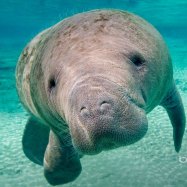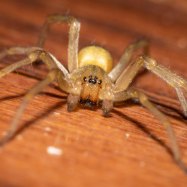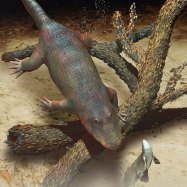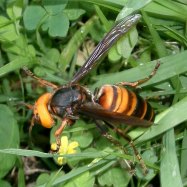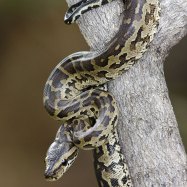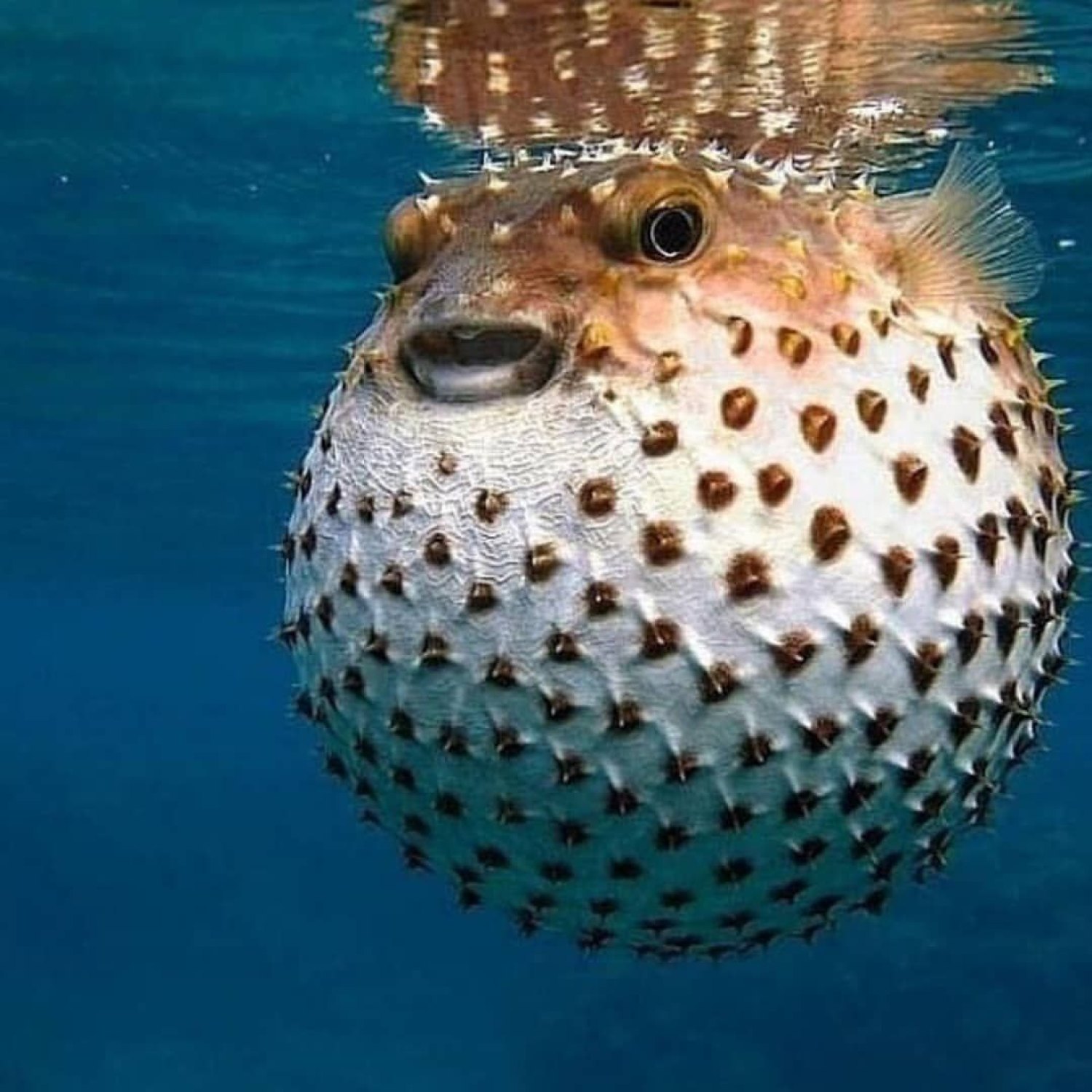
Pufferfish
1 to 2 feet (30 to 60 cm)
Did you know pufferfish can be found in oceans, seas, and coral reefs around the world? These playful fish, also known as blowfish, belong to the Tetraodontidae family. With their round and inflated body shape, they can grow up to 1 to 2 feet in length. But beware, their cute appearance is deceiving, as they are venomous and can puff up to twice their size when threatened. #pufferfish #oceanlife #underwaterwonders
Animal Details Summary:
Common Name: Pufferfish
Kingdom: Animalia
Habitat: Marine
The Fascinating World of the Pufferfish
In the vast and diverse world of marine life, there are countless species that fascinate and captivate us with their unique characteristics and behaviors. The pufferfish, scientifically known as Tetraodontidae, is one such creature that never fails to amaze us. With its distinctive appearance and fascinating features, the pufferfish has captured the curiosity and interest of people all around the world. In this article, we will take a deep dive into the world of the pufferfish, learning about its habitat, feeding habits, behavior, and more Pufferfish. So, grab your scuba gear and let's embark on an underwater adventure to discover this incredible animal.Meet the Pufferfish
The pufferfish, also commonly called the blowfish, is a type of mostly tropical and subtropical fish that belongs to the family Tetraodontidae. These fish are also found in freshwater and brackish habitats, but the majority of them are marine species. The pufferfish is known for its unique shape and behavior, making it one of the most recognizable and beloved species in the ocean. They are part of the ‘Ray-finned fish’ class, more specifically the order Tetraodontiformes, which includes other species such as triggerfish and boxfish.A Not-So-Threatening Appearance
One of the most striking features of the pufferfish is its appearance. These fish have a round and inflated body shape, which makes them stand out among other marine creatures. Their body is covered in small spines, which act as a deterrent for potential predators. The appearance of the pufferfish is further enhanced when it is feeling threatened or frightened Pine Siskin. In such situations, the fish inflates its body, making it appear much larger than its actual size. This not only makes them an intimidating sight but also makes it difficult for predators to swallow them.Diverse Coloration
While most of us may associate the pufferfish with its signature yellow and black stripes, the reality is that these fish can come in various colors and patterns. Some species have a more muted coloration, while others have vibrant hues and intricate patterns on their bodies. This diversity in color and patterns is not only visually appealing but also serves as a way for the fish to blend in with its surroundings and avoid being noticed by predators.The Secret Weapon: Tetrodotoxin
Apart from their unique shape and appearance, pufferfish also have a secret weapon in their arsenal – tetrodotoxin. This powerful neurotoxin is found in various parts of their body, such as the skin, liver, and ovaries. It is one of the most potent toxins found in nature, over a thousand times stronger than cyanide. The pufferfish uses this toxin as a defense mechanism, which can be fatal to predators and even humans if consumed in high doses. This makes the pufferfish one of the most dangerous animals in the sea.Feeding Habits of the Pufferfish
Despite their timid nature, pufferfish are actually carnivorous and have a varied diet. They primarily feed on small creatures such as crustaceans, mollusks, and algae. They have powerful jaws and teeth that help them crush hard-shelled prey, and their beak-like mouths are perfect for picking off small prey from crevices. Their diet also consists of small fish and sometimes carrion. Pufferfish are known to be opportunistic feeders, and they are not picky when it comes to their food choices. This is necessary for their survival, as they have a slow swimming speed, making it difficult for them to catch prey.Life in the Ocean
The pufferfish is a widespread species, found in oceans, seas, and coral reefs. They are primarily found in tropical and subtropical regions, making their homes in warm and shallow waters. While some species prefer to swim in large schools, others are solitary creatures. Due to their delicate nature, pufferfish are not strong swimmers and rely on their unique defense mechanisms to survive in the ocean.A Timidly Aggressive Nature
Contrary to their harmless appearance, pufferfish are known to exhibit timidly aggressive behavior. They are generally shy creatures and tend to stay hidden in crevices or among rocks. However, when feeling threatened, they can become aggressive and release their toxin as a defense mechanism. They may also use their inflated body as a way to intimidate predators. This behavior is not limited to predators; pufferfish have also been known to exhibit aggression towards each other, especially during mating season.The Pufferfish and its Role in Marine Ecosystems
Apart from being one of the most fascinating species in the ocean, pufferfish also play a crucial role in maintaining the balance of marine ecosystems. As predators, they help control the population of their prey, thus preventing overgrazing on algae and other vegetation. They also serve as a food source for other marine creatures, contributing to the intricate food web of the ocean.Conservation Status and Threats
While pufferfish may seem abundant in the oceans, they are facing significant threats that put their population at risk. One of the primary threats is overfishing, as these fish are highly sought after for consumption in various parts of the world. Apart from being utilized for food, some cultures also use pufferfish in traditional medicine. This, coupled with the destruction of their habitats due to pollution and climate change, has led to a decline in the pufferfish population. There is also a threat posed by the illegal pet trade, as these fish are commonly kept in aquariums.The Pufferfish as a Symbol
The unique and fascinating features of the pufferfish have captured the imagination of humans for centuries. They have been featured in various forms of art, literature, and even as a mascot for some sports teams. In some cultures, the pufferfish is seen as a symbol of good luck, while in others, it represents strength and resilience.Wrapping Up
In conclusion, the pufferfish is truly a remarkable creature, with its distinctive appearance and fascinating behaviors. While it may seem like a harmless and cute fish, it possesses powerful defense mechanisms that have made it one of the most resilient and adaptive species in the ocean. However, the threats faced by these fish remind us of the importance of conservation and protecting our delicate marine ecosystems. So, the next time you come across a pufferfish, remember to admire it from a safe distance and appreciate its role in the intricate world of marine life.

Pufferfish
Animal Details Pufferfish - Scientific Name: Tetraodontidae
- Category: Animals P
- Scientific Name: Tetraodontidae
- Common Name: Pufferfish
- Kingdom: Animalia
- Phylum: Chordata
- Class: Actinopterygii
- Order: Tetraodontiformes
- Family: Tetraodontidae
- Habitat: Marine
- Feeding Method: Carnivorous
- Geographical Distribution: Tropical and subtropical regions
- Country of Origin: Various
- Location: Oceans, seas, and coral reefs
- Animal Coloration: Varies; often covered in spines
- Body Shape: Round and inflated
- Length: 1 to 2 feet (30 to 60 cm)
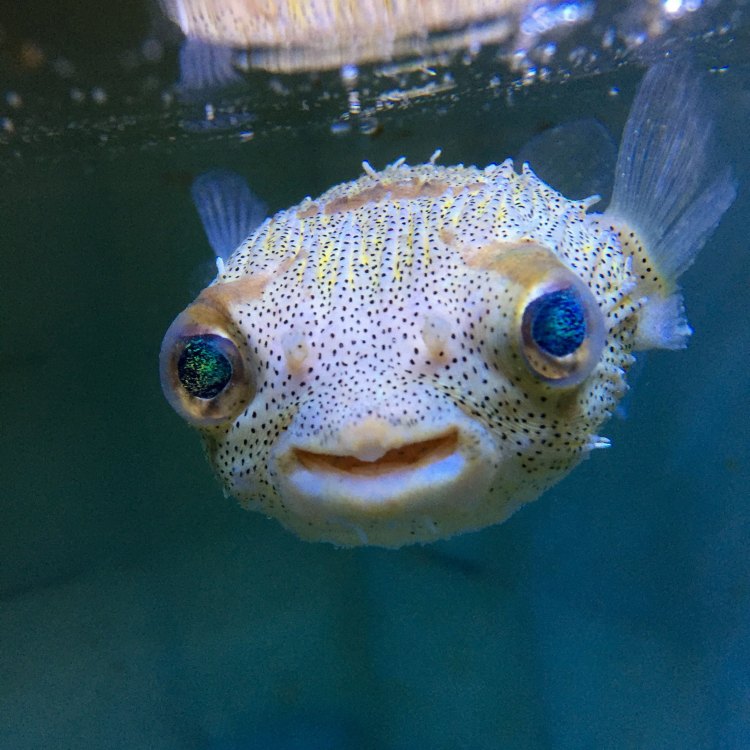
Pufferfish
- Adult Size: Varies by species
- Average Lifespan: 5 to 10 years
- Reproduction: Sexual
- Reproductive Behavior: Males court females through displays
- Sound or Call: Usually silent
- Migration Pattern: May migrate short distances
- Social Groups: Solitary or small groups
- Behavior: Can inflate their bodies as a defense mechanism
- Threats: Overfishing, habitat destruction, pollution
- Conservation Status: Varies by species
- Impact on Ecosystem: Important role in balancing coral reef ecosystems
- Human Use: Often caught for food, aquarium trade
- Distinctive Features: Ability to inflate their bodies, spines
- Interesting Facts: Some pufferfish species are highly toxic
- Predator: Sharks, dolphins, larger fish
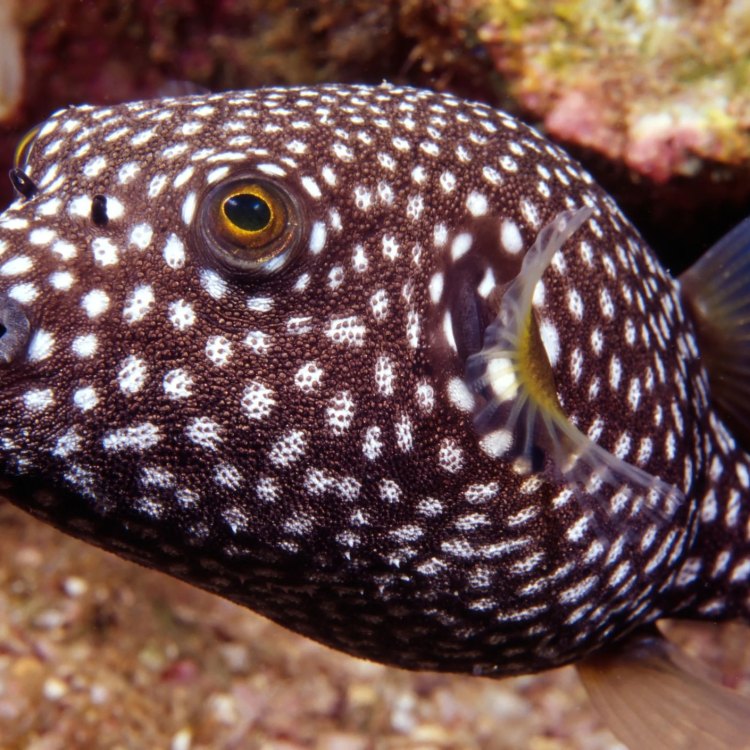
Tetraodontidae
The Magnificent and Deadly World of Pufferfish
In the vast depths of the ocean, there is a creature that commands both mystery and admiration - the pufferfish. With its unique and intriguing features, this species of fish has captured the attention of not just marine biologists and divers, but also that of the general public.The pufferfish, also known as blowfish, is a fascinating fish that belongs to the Tetraodontidae family. There are over 120 species of pufferfish, found in various oceans and seas around the world PeaceOfAnimals.Com. They are known for their distinctive ability to inflate their bodies, making them almost twice their size.
These compact creatures may seem small and harmless, but there is more to them than meets the eye. Let us dive deeper into the world of pufferfish and uncover their unique features, behavior, and importance in our ecosystem.
The Size and Lifespan of Pufferfish
One of the most striking features of pufferfish is their varying sizes. Depending on the species, they can grow anywhere from a few inches to several feet long. Some of the largest species can even reach up to three feet in length.On average, pufferfish have a lifespan of 5 to 10 years. However, some species have been known to live for over 20 years in captivity. In the wild, their lifespan may be shorter due to various factors such as predation and environmental changes Pyrador.
Sexual Reproduction and Courting Behavior
Pufferfish are sexual reproducers, meaning they require a male and a female to mate and produce offspring. During the breeding season, male pufferfish will use flashy displays to attract potential mates. They will swim around the female, showing off their vibrant colors and patterns. Some species even have the ability to change their color to impress the female.If the female is interested, she will respond by changing her color and swimming closer to the male. This courtship behavior can last for several minutes and is a beautiful sight to behold. Once the female has chosen a mate, they will swim together to find a suitable place for her to lay her eggs.
Silent Creatures with Short-distance Migration
Unlike many other marine species, pufferfish are usually silent creatures. They do not produce sounds or calls like dolphins or whales. However, some species have been observed making soft clicking noises to communicate or identify themselves to other pufferfish.Pufferfish may also engage in short-distance migration within their habitat. They may move to different areas in search of food or suitable breeding grounds. However, their migration patterns are not as extensive as some other fish species.
Solitary or Small Groups
Pufferfish can be found living alone or in small groups of two to eight individuals. They are not social creatures and do not form large schools like other fish species. Instead, they prefer to live a solitary life, venturing out to find food and returning to their hiding spot.However, some species of pufferfish have been observed forming small groups for feeding or breeding purposes. It is believed that this behavior also serves as a defense mechanism against predators.
Unique Defense Mechanism: Inflating Their Bodies
One of the most fascinating features of pufferfish is their ability to inflate their bodies. This is a unique defense mechanism that helps them protect themselves from predators. When threatened, they take in water and air, making their body swell, and their spines stand erect.This inflation technique makes it difficult for predators to swallow them or attack them. Some species also have sharp spines that can cause harm to their attackers. This defense mechanism is crucial for the survival of pufferfish in the wild.
Threats to Pufferfish: Overfishing, Habitat Destruction, and Pollution
Despite their compact size and defense mechanism, pufferfish face many threats in their natural habitat. Overfishing is one of the most significant threats, with these fish being popular in the food industry and the aquarium trade. Their unique appearance and ability to inflate their bodies make them a popular choice for aquarium enthusiasts.Habitat destruction is another significant threat to pufferfish. As coral reefs and seagrass beds get damaged due to human activities like destructive fishing practices and pollution, the habitats of pufferfish get disrupted. This leads to a decline in their population and affects the equilibrium of the ecosystem.
Pollution, especially plastic waste, is another major threat to pufferfish. These creatures often mistake floating plastic for food and end up ingesting it, causing harm or death. Plastic pollution also affects their natural habitats and can lead to entanglement and suffocation.
The Fragile Conservation Status of Pufferfish
The conservation status of pufferfish varies depending on the species. Some species are listed as "Least Concern," while others are classified as "Vulnerable" or "Endangered." The diverse range in their conservation status is due to the varying population sizes and threats that each species faces.It is essential to monitor the population and conservation status of all pufferfish and take measures to protect their habitats and ensure their survival.
The Vital Role of Pufferfish in Balancing Coral Reef Ecosystems
Pufferfish may look like small and insignificant creatures, but they play a crucial role in balancing the delicate coral reef ecosystems. These fish feed on plants and invertebrates like mussels and snails, keeping their populations in check. This prevents overgrowth and allows coral reefs to thrive.Furthermore, their excretion of nutrient-rich waste helps to fertilize the surrounding water, providing the necessary nutrients for the growth of corals and other marine plants. Their presence also helps to maintain a healthy balance between predators and prey in the ecosystem.
Human Use of Pufferfish: From Food to Aquarium Trade
Unfortunately, pufferfish are not just admired and studied in their natural habitats but also used by humans for various purposes. In many cultures, pufferfish are considered a delicacy and are used in traditional dishes like sashimi and soups. These fish are also used in traditional medicine in some countries.In the aquarium trade, pufferfish are sought after for their unique appearance and behavior. They require special care and a suitable environment to thrive in captivity. However, it is essential to ensure that they are sourced ethically and do not harm wild populations.
Distinctive Features: Inflation and Sharp Spines
The most distinctive feature of pufferfish is their ability to inflate their bodies. While this is commonly known, many people are not aware that not all pufferfish species possess this ability. Some species have lost this trait over time due to environmental factors or evolution.Besides inflation, pufferfish also have sharp spines that cover their bodies. These spines serve as a warning to predators and also provide protection when the fish inflates itself. This distinctive feature is what gives these fish their scientific name Tetraodontidae, which translates to "four-toothed."
Fascinating Facts About Pufferfish
Apart from their unique features, pufferfish are full of surprising and fascinating facts. For instance, some species have highly toxic skin and organs that can be fatal to predators and humans if consumed. This toxin, tetrodotoxin, is more potent than cyanide and has no known antidote.Another interesting fact is that pufferfish have the smallest bones of any vertebrate, with some species having bones the size of a needle. They also have the ability to rotate their eyes independently, giving them a 360-degree view of their surroundings.
Predators of Pufferfish: Sharks, Dolphins, and Larger Fish
Despite their defense mechanism, pufferfish are not entirely immune to predators. Their ability to inflate themselves can backfire if they are caught by a shark or dolphin, as these animals can easily puncture their inflated body. Larger fish, such as barracudas and groupers, may also prey on pufferfish, using their powerful jaws to crush their spines.The Continued Fascination with Pufferfish
In conclusion, the pufferfish is an intriguing creature that continues to capture the attention and admiration of many. Their unique features, behavior, and importance in our ecosystem make them a crucial species that we must protect.As we continue to learn more about these creatures, we must also be more cognizant of our actions and how they affect the delicate balance of our oceans. From overfishing to pollution, we must take responsibility for our actions and work towards preserving the enchanting and deadly world of pufferfish.
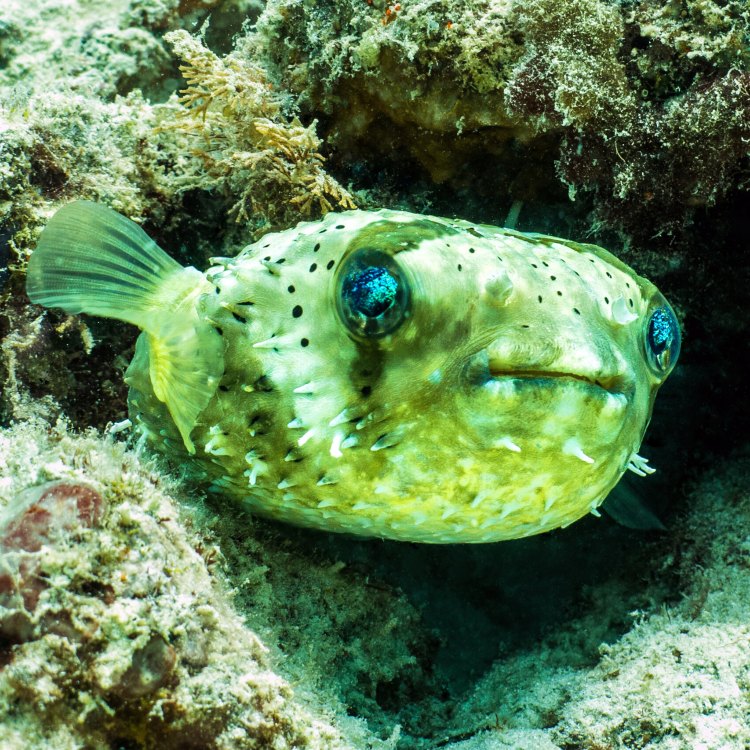
The Fascinating World of the Pufferfish
Disclaimer: The content provided is for informational purposes only. We cannot guarantee the accuracy of the information on this page 100%. All information provided here may change without prior notice.




